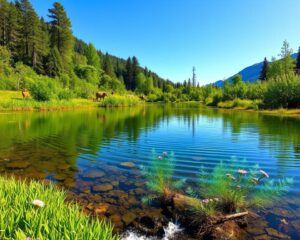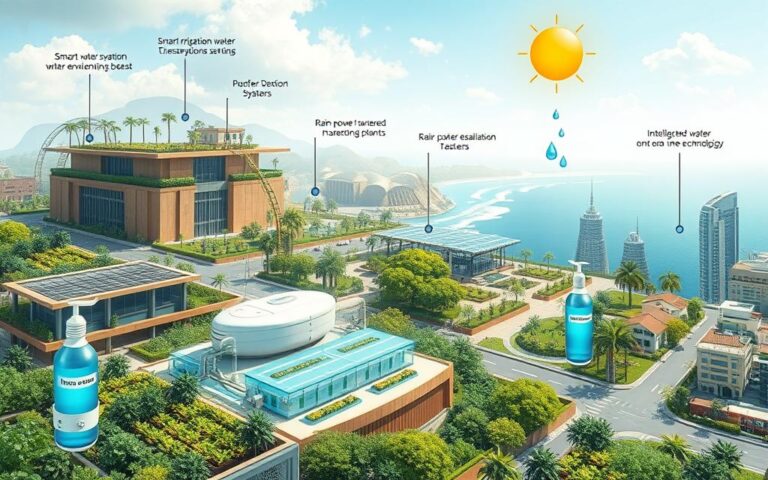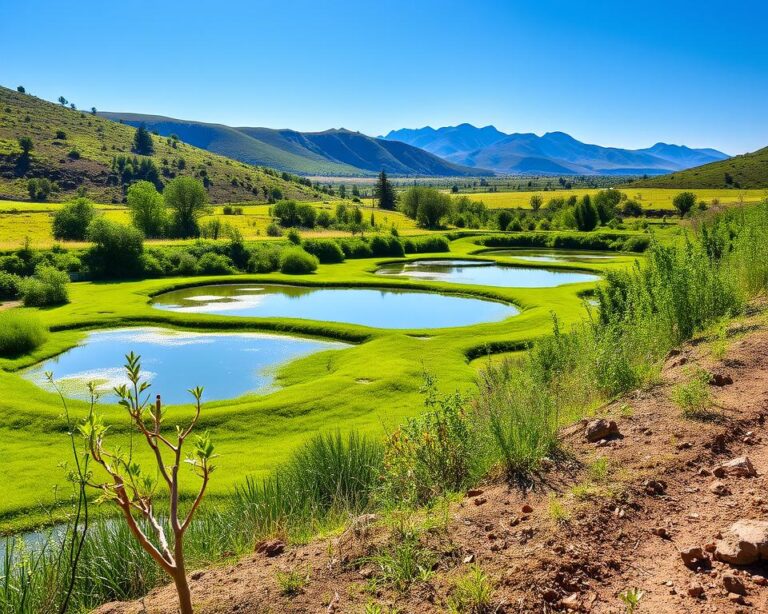Did you know that 27% of the 29,500 freshwater-dependent species are threatened? The need to protect freshwater is urgent. Only 2.5% of the planet’s water is fresh, mostly in glaciers. This makes it very limited.
Freshwater ecosystems are crucial for our survival. They support biodiversity, agriculture, and add $50 trillion in economic value. Clean water and sustainable management are key to fighting climate change and pollution.
Human activities harm these vital resources. It’s important to act now. By using water wisely, we ensure future generations have water and protect our planet’s health.
Understanding Freshwater Resources
Freshwater is key to life on Earth. It includes rivers, lakes, glaciers, and aquifers, making up less than three percent of all water. The rest, about 97 percent, is salty ocean water. Freshwater is essential for drinking, farming, and energy.
What Are Freshwater Resources?
Freshwater resources are vital. About 69 percent is frozen in glaciers and ice caps. Another 30 percent is underground. Yet, only one percent is easily accessible for us.
Scarcity leads to water stress for nearly one-fifth of the world’s population. This stress causes over three million deaths yearly. From 1990 to 2015, 2.6 billion people gained access to better water. Yet, one billion in Africa and Asia still struggle to find safe water.
Importance of Freshwater Ecosystems
Freshwater ecosystems are crucial for life. They support rivers, lakes, and wetlands, home to many species. Sadly, nearly a third of these ecosystems have vanished, with species numbers dropping by 83% since 1970.
Most freshwater, about 70 percent, goes to farming. This shows the need to balance human use with nature. By 2030, we aim to protect one million kilometers of rivers and 30 million hectares of lakes and wetlands. Preserving biodiversity and water quality is essential for our health and the planet’s.
| Freshwater Resource Type | Percentage of Total Freshwater | Accessibility |
|---|---|---|
| Glaciers and Ice Caps | 69% | Not readily accessible |
| Groundwater | 30% | Partially accessible |
| Surface Water (Lakes, Rivers) | 1% | Readily accessible |
The Current State of Freshwater Supplies
Freshwater resources face big challenges, mainly due to water scarcity. Billions of people worldwide struggle with this issue, especially in poor areas. As more people live on Earth and climate change worsens, it’s key to know how freshwater supplies are doing.
Global Water Scarcity Issues
Water shortages are a big worry. By 2025, two-thirds of the world’s people might not have enough water. The National Geographic Society’s World Freshwater Initiative is working to solve these problems.
It focuses on making sure we have enough, good-quality water. Local communities are at risk if things keep getting worse. They need our help to survive.
The Impact of Climate Change
Climate change makes water problems worse. Weather patterns change, causing droughts and floods. This messes up water flow and important ecosystems.
For example, the Okavango Wilderness Project shows we need to protect water sources. We must work together to keep our water and land safe. This is crucial to fight climate change’s effects.
| Indicators | Effect of Climate Change | Water Scarcity Risk |
|---|---|---|
| Temperature Increase | Higher evaporation rates | Reduces freshwater availability |
| Extreme Weather Events | Droughts and floods | Disrupts water supplies |
| Changes in Aquatic Biodiversity | Decline in species health | Affects local fisheries and food resources |
| Pollution from Deforestation | Increased run-off into water bodies | Reduces water quality and ecosystem health |
The Role of Agriculture in Water Use
Agriculture is a big user of freshwater, making up a large part of global water use. This section looks at how irrigation and water management can help save water in farming. By using efficient methods, you can help make farming more sustainable and ensure plants get enough water.
Irrigation Practices and Water Management
Using water wisely in farming is key. Here are some important methods:
- Drip Irrigation: This method cuts down on water lost to evaporation and runoff. It delivers water right to the roots of plants.
- Efficient Irrigation Scheduling: Adjusting when you water based on the type of crop, its growth stage, and soil moisture is very effective.
- Water Capture and Storage: Creating systems to catch and store rainwater can be a reliable source of water during dry times.
Sustainable Farming Techniques
Using sustainable agriculture methods can greatly help save water in farming. Here are some ways to do it:
- Compost and Mulch: These improve soil health and help it hold onto water better, reducing the need for irrigation.
- Cover Crops: These crops help keep water in the soil by reducing runoff and improving soil’s ability to hold water.
- Crop Rotation: Growing different crops together can help restore soil moisture and reduce pest problems.
These methods show how important it is to make farming sustainable for better water management. By focusing on saving water, you help protect this vital resource for future generations.
Everyday Actions to Save Water
Everyday actions can greatly help save water. Simple changes at home can cut down water use and support sustainability. Here are some easy tips to make a big difference.
Tips for Reducing Water Usage at Home
Every home can find ways to use less water. Here are some easy tips:
- Fix any leaks quickly to avoid wasting water.
- Shorten your showers to save up to 5 gallons of water for every minute less.
- Turn off the tap while brushing your teeth to save about 6 litres of water per minute.
- Only run the dishwasher when it’s full to avoid wasting water.
- Try water-efficient landscaping like xeriscaping, which uses less water than traditional lawns.
Water-Saving Appliances and Fixtures
Switching to water-saving appliances and fixtures can help a lot. Here are some good options:
| Appliance/Fixture | Water Usage | Benefits |
|---|---|---|
| Low-flow showerheads | 1.5-2.5 gallons per minute | Reduces water flow without sacrificing pressure. |
| Dual-flush toilets | 1.1-1.6 gallons per flush | Significant water savings by choosing a lower flush option. |
| Energy-efficient dishwashers | 3-5 gallons per load | Saves water compared to washing dishes by hand. |
| Washing machines (high-efficiency) | 15-30 gallons per load | Uses less water and energy than conventional models. |
| Water butts for rainwater collection | Varies | Can save up to 5,000 litres of water a year. |
Try these home conservation efforts and install low-flow fixtures. With a little planning and habit change, saving water is easier than ever.
Community Involvement in Preservation
Getting communities involved is key to saving our freshwater. Local efforts are vital in teaching people how to save water. By joining these programs, you help keep our water sources healthy.
Local Initiatives and Programs
Many local projects aim to get people involved in water issues. They include:
- Cleanup events where people come together to clean rivers and lakes.
- Educational workshops that teach people how to save water and use resources wisely.
- Sustainable landscaping projects that use plants and designs that save water.
Supporting and joining these efforts strengthens our community’s water-saving spirit.
How You Can Get Involved
There are many ways to help. Here are a few:
- Join groups that work on saving water in your community.
- Go to workshops to learn more about saving water.
- Speak up for laws that help protect our water.
Every little bit helps in saving our freshwater. Together, we can make a big difference.
Choosing Sustainable Products
When you buy products, you help save freshwater. Knowing how these items affect our planet is key. This includes their water footprints. We’ll look at why water footprints matter and find eco-friendly brands that care about our planet.
Understanding Water Footprints
Water footprints show how much water is used to make goods and services. This includes water used in making and using products. Choosing products with smaller water footprints helps save water.
By thinking about a product’s water footprint, you can pick items that help conserve water. This is good for our planet’s freshwater.
Supporting Brands Committed to Conservation
Buying from eco-friendly brands is important. These brands work hard to reduce their environmental impact. They often show how they save water.
Here are some eco-friendly brands:
- Patagonia – This outdoor clothing brand focuses on ethical and sustainable products.
- Seventh Generation – They make eco-friendly cleaning supplies and focus on sustainability.
- Dr. Bronner’s – Their biodegradable soaps support environmental care and fair trade.
Supporting these brands helps make a difference. It encourages others to care about water too. By choosing wisely, you help protect our freshwater resources.
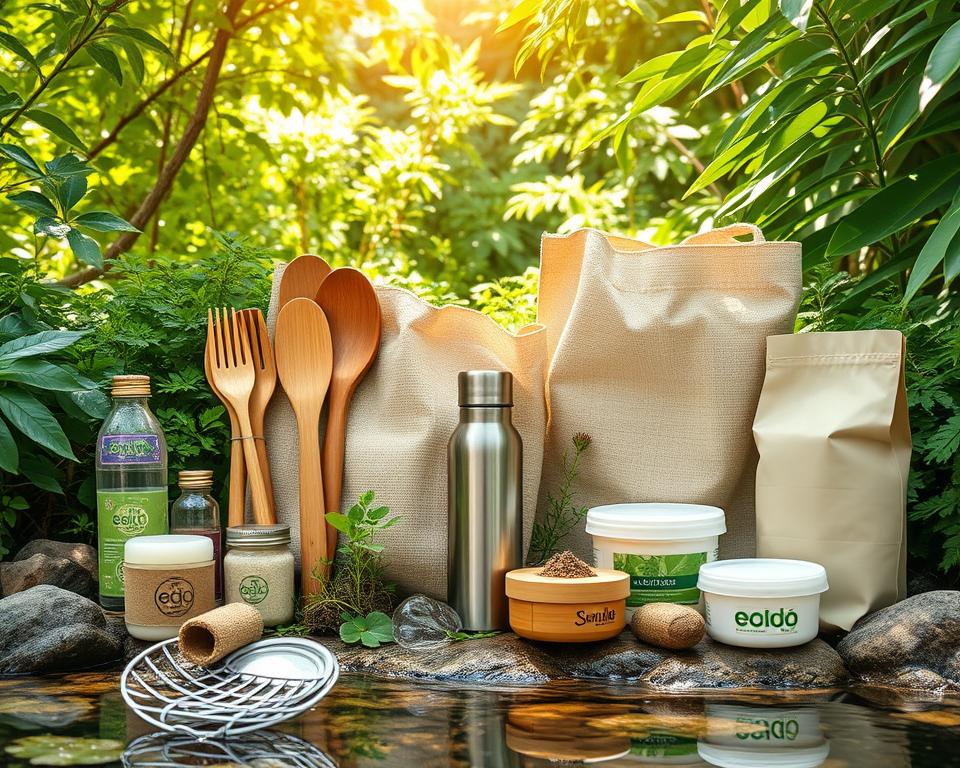
Protecting Wetlands and Watersheds
Wetlands and watersheds are vital for many ecosystems. They filter water, control floods, and support habitats. These ecosystems are crucial, offering over $450 billion in benefits to sectors like tourism and manufacturing.
Importance of Wetland Ecosystems
Wetlands protect biodiversity and keep water clean. They are homes for many species and fight pollution. Sadly, 40-50% of U.S. water bodies are harmed by pollutants.
Protecting wetlands is key. They save coastal areas about $23 billion in flood damage yearly. They also help during storms, like Hurricane Sandy.
How to Advocate for Local Watershed Protection
Supporting conservation advocacy is vital for healthy watersheds. You can help by joining local efforts for watershed protection. Here are some ways:
- Support local groups that protect wildlife and manage watersheds.
- Learn about pollution causes and the need for proper waste disposal.
- Use hardy plants in landscaping to cut down on fertilizers and pesticides.
- Adopt sustainable habits, like saving water and avoiding harmful chemicals.
These actions help keep our watersheds healthy. By getting involved, you join a movement crucial for our ecosystems’ future.
Conserving Water in Your Garden
Water conservation in gardening is key to saving our freshwater. Choosing native plants and using drought-resistant landscaping helps. These methods make your garden thrive with less water and support local wildlife. Also, using rainwater harvesting boosts your gardening efforts.
Native Plants and Drought-Resistant Landscaping
Native plants fit your local climate and soil perfectly. They use water efficiently. Drought-resistant landscaping means less watering, which is great for areas with limited water.
Here are the benefits:
- Lower Water Requirements: Native plants need less water.
- Reduced Maintenance: They’re hardy, so you use fewer chemicals.
- Enhanced Biodiversity: They support local wildlife.
- Soil Health: They help soil stay moist and stable.
Rainwater Harvesting Techniques
Rainwater harvesting is a big help in saving water. It collects and stores rainwater for your plants. This way, you don’t rely on city water.
Here’s how to start:
- Install Rain Barrels: Place barrels under downspouts to catch roof runoff.
- Create a Filter System: Use screens to keep debris out.
- Connect Soaker Hoses: Spread the water evenly in your garden.
- Utilize Diverters: Direct rainwater from gutters to storage.
Small changes can make a big difference. By using native plants, drought-resistant landscaping, and rainwater harvesting, you help the environment. Plus, your garden will flourish.
Policies and Legislation for Freshwater Protection
Effective policies and laws are key to protecting freshwater. Laws at different government levels safeguard our water resources. They aim to protect wetlands, streams, and lakes. They also promote the sustainable use of freshwater.
Overview of Key Water Conservation Laws
Many states have created laws to manage freshwater wisely. For instance, New Jersey values its freshwater wetlands, lakes, and streams at about $10.1 billion yearly. They provide clean water and help control floods. Some notable laws include:
- Setting a minimum stream buffer width of 150 feet to protect streams and wetlands.
- Lowering the “major development” threshold from one acre to half an acre for better stormwater management.
- Adding surface water bodies with significant wetlands to stream corridor ordinances.
The Role of Government and Agencies
Government agencies play a big role in enforcing freshwater policies. They ensure laws are followed. Their tasks include:
- Reviewing development applications by local boards.
- Encouraging public input through hearings.
- Working with landowners and nonprofits to preserve wetlands and streams.
With the growing need to protect freshwater, knowing the government’s role is crucial. Good management not only preserves biodiversity. It also ensures we have access to water for our health and the environment.
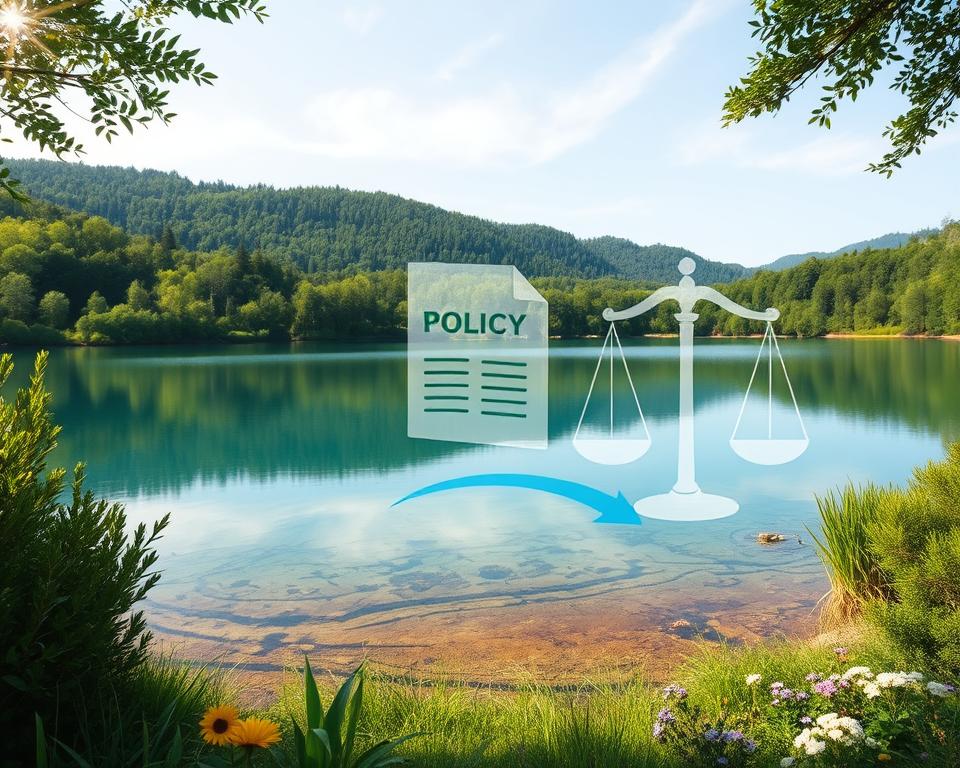
The Future of Freshwater Resources
The future of freshwater will depend on new technologies. Desalination, better wastewater treatment, and smart irrigation are key. These innovations are crucial for meeting global water needs.
Over 80% of the world’s wastewater is not treated. Using these technologies is vital for our water supplies. They help protect our freshwater ecosystems, making our planet healthier.
Innovative Technologies in Water Preservation
New water management technologies are emerging. They aim to tackle challenges from climate change and growing demand. For instance, better wastewater treatment can recycle water for farming.
Currently, 70% of freshwater is used for farming. Improving water management can prevent saltwater intrusion from sea level rise. This threat affects aquifers. With these advancements, the future of freshwater looks bright.
How You Can Help Shape the Future
You can make a big difference in freshwater conservation. Join local efforts, support sustainable practices, and spread the word about water protection. Your actions can help create a culture of conservation.
Together, we can ensure everyone has access to safe, sustainable water. This will greatly improve life for all of us.

